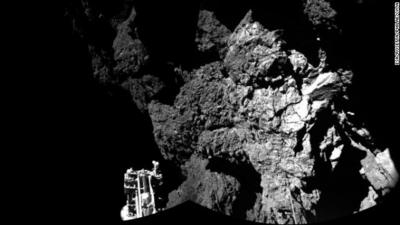Sat, Nov 15, 2014
Spacecraft's Harpoons Did Not Deploy, Now Apparently Lying On Its Side In A Crevice On The Comet's Surface
On Wednesday, Nov. 12, the European Space Agency's Rosetta mission successfully landed on the surface of comet 67P/Churyumov-Gerasimenko. Descending at a speed of about 2 mph the lander, called "Philae," first touched down and its signal was received at 11:03 a.m. EST.

Partially due to anchoring harpoons not firing, and the comet's low gravity (a hundred-thousand times less than that of Earth), Philae bounced off the surface and flew up to about six-tenths of a mile both above the comet's surface as well as downrange. At 12:53 p.m. EST, almost two hours after first contact, Philae again touched down. A second, more modest bounce resulted, again sending it airborne. Philae's third contact with the comet's nucleus was the charm. At 1 p.m. EST, the Rosetta mission's Philae lander became the first spacecraft to soft-land on a comet.
Rosetta mission controllers believe Philae alighted in a hole, or crevice, about six feet in diameter and six feet deep and that it is lying on its side. While the lander remains unanchored to the surface, it remains stable. and eight of its 10 instruments have already begun sending back data. The science team is working on its next moves.
"Philae is on the surface and doing a marvelous job, working very well, and we can say we have a very happy lander," said Paolo Ferri, ESA's head of mission operations at the European Space Operations Center, Darmstadt, Germany.
Teams are still working to confirm the location and the overall power and thermal situation on board. The lander did receive power from some of its solar panels. It appears that some parts of the lander were in shadow during the time that last night's surface telemetry data were being transmitted.
Launched in March 2004, Rosetta was reactivated in January 2014 after a record 957 days in hibernation. The mission consists of an orbiter and lander. Its objectives since arriving at comet 67P/Churyumov-Gerasimenko this summer have been to study the celestial object up close in unprecedented detail, and prepare for Philae's landing. The orbiter will continue tracking the comet's changes as it sweeps past the sun.
(Image provided by ESA)
More News
Minimum Friction Level The friction level specified in AC 150/5320-12, Measurement, Construction, and Maintenance of Skid Resistant Airport Pavement Surfaces, that represents the m>[...]
Aero Linx: Airpower Museum The APM owns 30 acres on Antique Airfield, including the south half of the N-S runway. It consists of three hangars, an annex, and a library. The museum >[...]
Patient Told The First Responders That The “Man Who Was In The Plane Was Flying At The Time Of The Accident And Had Overshot The Runway They Were Attempting To Land On.&rdquo>[...]
Klyde Just Can't Believe This Has Gotten To This Point... FMI: www.klydemorris.com>[...]
Also: Duffy Wants $$$, KS Airports, Morningside U’s Aviation School, New Airstrip In ID After 6 were killed in a helicopter crash over the Hudson River, several US Representa>[...]
 ANN's Daily Aero-Term (06.02.25): Minimum Friction Level
ANN's Daily Aero-Term (06.02.25): Minimum Friction Level ANN's Daily Aero-Linx (06.02.25)
ANN's Daily Aero-Linx (06.02.25) NTSB Prelim: Champion 7ECA
NTSB Prelim: Champion 7ECA Classic Klyde Morris (From 06.10.22)
Classic Klyde Morris (From 06.10.22) Airborne 05.30.25: Anti-Helicopter Bill, PW Strike Done, All-Electric Bristell
Airborne 05.30.25: Anti-Helicopter Bill, PW Strike Done, All-Electric Bristell



